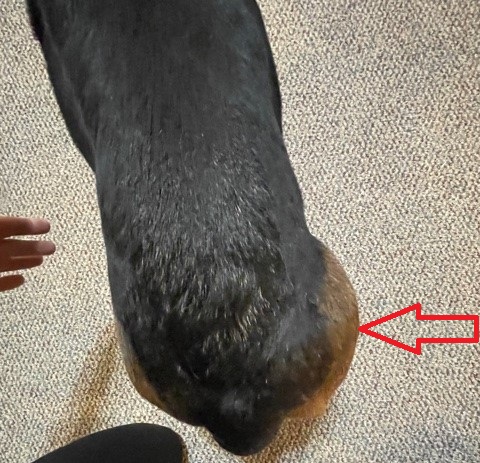Long story short, this was a classic case of an unusual type of fatty tumor, aka lipoma. It’s called an inter-muscular lipoma, which means that it lives under a muscle, or between muscles. In Majic’s case, it was between the muscles of the back of the thigh, in other words, inside the hamstring!

Compare the bulge in the right thigh (red arrow) to the rather flat left thigh.
Because it can grow to such an impressive size, this type of mass can be misdiagnosed as a more serious tumor (translation: cancer) because it presents as a large, firm, non-movable mass.
This is a big deal because if an owner is told a mass cannot be removed or their pet isn’t a good candidate for surgery, then they wait. And when well-intentioned pet owners wait around, masses get bigger and bigger, which can make the mass more difficult to remove. The pet suffers, surgery is more invasive, and the outcome may be far worse.
Fortunately, Majic’s owner didn’t wait around.
What’s very unusual about Majic is that he had the exact same type of lipoma in the left thigh about one year earlier!
So he had surgery twice.
Majic’s owner SB writes: “We are always a bit worried when one of our dogs must experience anesthesia. We worried about whether the surgery was worth it because Majic was nine years old.”
Removal of an intermuscular lipoma is typically straightforward. In the thigh, the trickiest part is to be gentle with the sciatic nerve (think sciatica), which lives right in the area of the mass. Damaging this important nerve could have devastating consequences.
Below is a video of Majic’s second surgery.
Now, THIS IS NOT FOR THE FAINT OF HEART.
If you are a sensitive soul, please do not click.
If you accept the warning and you think you can stomach it, feel free to click: https://youtu.be/QjlQFpvW3h4.
After surgery, Majic’s owner wrote: “We felt relieved that the surgery was over and that Majic came out of surgery well. We were given lots of post-surgical info and what to look for to make sure healing happened as quickly as possible.”
Moral of the story: the smaller the mass, the better for the patient.
Majic’s owner writes: “We know we chose the best option for Majic. He’s back to normal, wrestling and sprinting around with the other two dogs, climbing onto our kitchen countertops if there is a crumb of anything, and enjoying his quiet moments in a pocket of sunshine wherever he can find it. We are thankful that these surgeries exist to help our four-legged family members.”
Phil Zeltzman, DVM, DACVS, CVJ, Fear Free Certified

